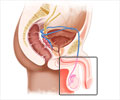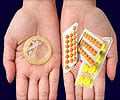Condoms originally invented for preventing pregnancies have recently also been under intense scrutiny to look at their role in protection against sexually transmitted diseases (e.g. Gonorrhea and 25 other related conditions) and HIV.
Two types of male condoms are available. These are usually Latex and polyurethane condoms. The other less popular condoms are lambskin condoms, or natural condoms.
Latex condoms provide excellent protection against STDs, the lambskin condoms provide no protection and the Polyurethane condoms provide some protection against STDs, although it is still not clear just how much.
What one needs to understand is that only some STDs are passed through the body fluids like the semen or vaginal secretion. The STDs that are passed through semen and blood include HIV/AIDS virus, hepatitis, chlamydia, and gonorrhea, whereas syphilis, herpes and human papillomavirus (also known as genital warts) occur on the skin of genitalia and can get passed from one partner to another even if a condom is used.
The effectiveness of a condom against STDs also depends on whether the condom was stored correctly, used correctly and if it was used all the time.
No Latex and polyurethane condoms are 100% effective in preventing STDs. The best protection is not to have sex. However as this is not a practical solution it is best to use a condom. To lessen the chances of getting an STD it is also recommended to use one partner who does not have an STD and who is not having sex with anyone else.
A recent study shows that incorrect use of Condom can lead to increased risk of gonorrhea infection. The study results emphasis that men should be thought that the incorrect use of condom can lead to infection. Researchers reviewed 1124 people visiting an STD clinic about their use of condoms and the mistakes they made while using a condom in the past 30 days.
More than half of the people interviewed during the study said they had not used a condom the last time they had sex. Within the past month, more than 40 percent of both men and women said they had not squeezed air out of the tip of the condom before using it. More than 40 percent of men and more than 30 percent of women reported that a condom broke during intercourse in the last month. One third of men and women said they had not held the base of a condom during withdrawal, and 24 percent of men and 30 percent of women did not leave a space at the tip of the condom. Many people also admitted that they started having sex before using a condom.
Women were more likely to say they had not left space at the tip or removed air from the tip of a condom before using it, while men were more likely to say they put on a condom inside out or had a condom break. More than 15 percent of study participants had either gonorrhea or Chlamydia. Men who said a condom had broken during the last 30 days were more than 90 percent more likely to have gonorrhea.
The tendency to assume that consistent condom users are using condoms correctly seriously underestimates their risk of transmitting or contracting STDs or becoming pregnant unintentionally. Thus it’s not enough to tell people to use condoms - they also need to learn how to use them correctly.
Further Information on Gonorrhea on Medindia:
Sexually Transmitted Diseases (STDs) were also known as venereal diseases. These are transmitted from one person to another through body contact during sex. What they all have in common is that they can be spread by sexual contact, including vagina, anal and oral sex.
Viruses, bacteria and parasites cause STDs and there are at least 25 different sexually transmitted diseases. The list of Sexually Transmitted Diseases or STDs / Venereal
Diseases is as follow:
Bacterial Vaginosis
Balanitis
Chlamydia
Pubic Lice
Epididymitis
Genital Herpes
Genital Warts
Gonorrhea
Amoebiasis
Giardiasis
Hepatitis
Molluscum
Non-Specific Urethritis
Scabies
Syphilis
Thrush
Trichomonas Vaginosis
Gonorrhea, also called, as ’’Clap’’ is a sexually transmitted, very common infectious disease. The infection is caused by a bacterium called Neisseria gonorrhea. Gonorrhea is spread during sexual intercourse – vaginal, oral, and anal. Most often, gonorrhea is found in younger people (ages 15-30) who have multiple sex partners. Gonorrhea can also be spread from mother to child during birth.
Brief History of Condoms:
1000 BC - Ancient Egyptians used a linen sheath for protection against disease (1)
100 - 200 AD – Cave Painting in France have found that condoms were used in some parts of Europe (2)
1500’s – First published account of condoms in Europe during the syphilis epidemic. Gabrielle Fallopius described linen sheath that he said would provide the necessary protection against the disease. Its use for birth control was only realized later!!
1700’s - Condoms made out of animal intestines were available. As they were expensive they were reused. The condom was described ’’an armour against pleasure, and a cobweb against infection’’.
1800’s - Rubber vulcanisation by Goodyear ( Car Tyre company founder) and Hancock revolutionized condom manufacturing and mass manufacturing started. Vulcanisation is a process, which turns the rubber into a strong elastic material. (3)
1900’s - Until the 1920’s, manufacturing involved hand-dipping method . These condoms were thicker and also aged quickly and quality was an issue often raised.
However Frederick Killian in 1919 started a new process and the latex condoms came into vogue. It had the advantage of ageing less quickly and being thinner and odourless. The condoms started selling in millions and became more popular.
In 1957- Durex introduced the first lubricated condom was launched in the UK by Durex.(5)
1960s – Decline in usage of Condoms with arrival of the Pill and coils.
1980s- Condoms found to be protective against HIV/ AIDS and the usage of condoms increased. So much so that now Condoms are also available in pubs, bars, grocery stores and supermarkets.
1992- Female condom approved by FDA
1994 - First polyurethane condom for men was launched in the US.Slowly coloured and flavoured condoms were also introduced.











